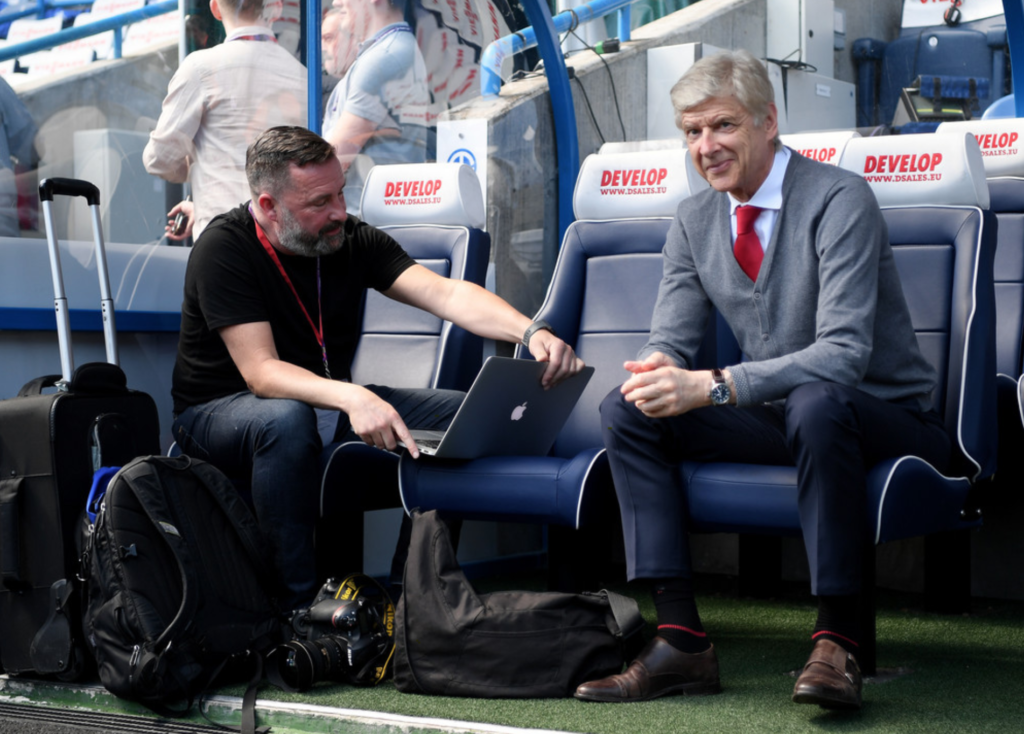He may not be the one who initially creates the golden moments for our club. However, perhaps even more importantly, he is the man behind capturing the photographies that makes the triumphs live long in the memories of us fans. We talk with Arsenals chief photographer Stuart Macfarlane, who since the days of George Graham has been an unmissable part of Arsenal Football Club.
It’s quiet around Emirates Stadium these days. The usual bustle around the club shops has disappeared, the same as the fans from near and far and their excitement to experience the buzz watching their beloved team play at the Emirates Stadium. Literally, no one is getting entrance to the stadium apart from a few selected Arsenal-staff members. The greenkeepers make sure that the pitch is still looking fresh and clean, so the Arsenal-players once again have the pleasure of kicking a ball on the famous pitch once the Coronavirus crisis is over. Between the stands has another Arsenal-staff member however found his place to document the greenkeepers. If not, then no one would. Since the early 1990s has Arsenals chief photographer Stuart Macfarlane been an ever-present figure in every corner at any given time in North London with his camera, ready to document the progress and history of the football club. Matchdays, training sessions, pre-season tours. Stuart is there to deliver stories, actions, and emotions through his pictures.
When it comes to Stuart’s own history with Arsenal, it goes even further back to days when he first started working for Arsenal. The red and white club from N5 has been no stranger for the photographer since his early days as a fan:
“My dad was a Chelsea fan and he took me over there to Stamford Bridge a few times, but I didn’t like it. It was in the mid-70’s-late ’70s, where there was a lot of trouble in football. But down the street where I lived, there was a guy who was a massive Arsenal-fan. He was the best footballer on the street, and you know I was only 6 or 7 years old back then, so while he was wearing his Arsenal kit, I followed him around and I did what he did. He was an Arsenal-fan, so I wanted to be like him, so I was an Arsenal-fan.”
Stuart’s own footballing career was spoiled by a few nasty injuries during his youth. He, however, kept his head high and found another way to get into the footballing world. With his talent to take pictures he soon found his way into a photo agency, where he two years later in 1990 was handed the task to take pictures for The Gunners. Soon after, he was able to take pictures of an Arsenal-team winning the championship in 1991 going through the season almost as invincibles. Since then Stuart has seen and been there to perpetuate the biggest highs and lows and everything in between for the club, he loves so much, but also works for. A privilege, the experienced photographer doesn’t take for granted:
“The biggest privilege of my job is literally just working for Arsenal. Growing up it was really the sort of prestigious football club. It just seemed so unachievable to work somewhere like to actually. Wherever I go in the world, people acknowledge you because it is such a respected football club. Just to say that I am there, that I work for this football club.
A fan without celebration
Just as much as Stuart has been there to track the progress of Arsenal, he has also taken part in the progress himself. When Arsenal was about to make their move in building the Emirates Stadium, the club needed a permanent photographer to document the process around the stadium project. Finding the right candidate for the job was rather easy for the club, and since 2001 has Stuart been able to call himself an employee at Arsenal. To document the building of Arsenal’s new home was however not one of Stuarts most challenging tasks. For Stuart, match days are even after all these years of experience still the most challenging days of his work:
“You want to get everything, you want to capture everything. I have never finished a game and thought, I haven’t missed a picture or something important in the game. Every game is a challenge. Sometimes the working conditions can be difficult. Some stadiums or the weather can be tricky. So match days really, stuff that is out of your control. Even though it can sound easy to be concentrated for 90 minutes it is not, especially if you love football and you sort of try to watch the game and follow it”.
During the years, Stuart has had to cope with being a fan and still be focused to capture the moments of the game. While everyone else is getting carried away of the game, Stuart needs to keep his head down:
“I’ve learned to enjoy it from a different perspective to a fan. I don’t celebrate goals physically, but in my head, I’m very happy when we score and we win. But I understand that I need to get pictures. Away from the camera, I’m not good at watching the team, very frustrated and shout a lot at the television. I’m best through the camera”.
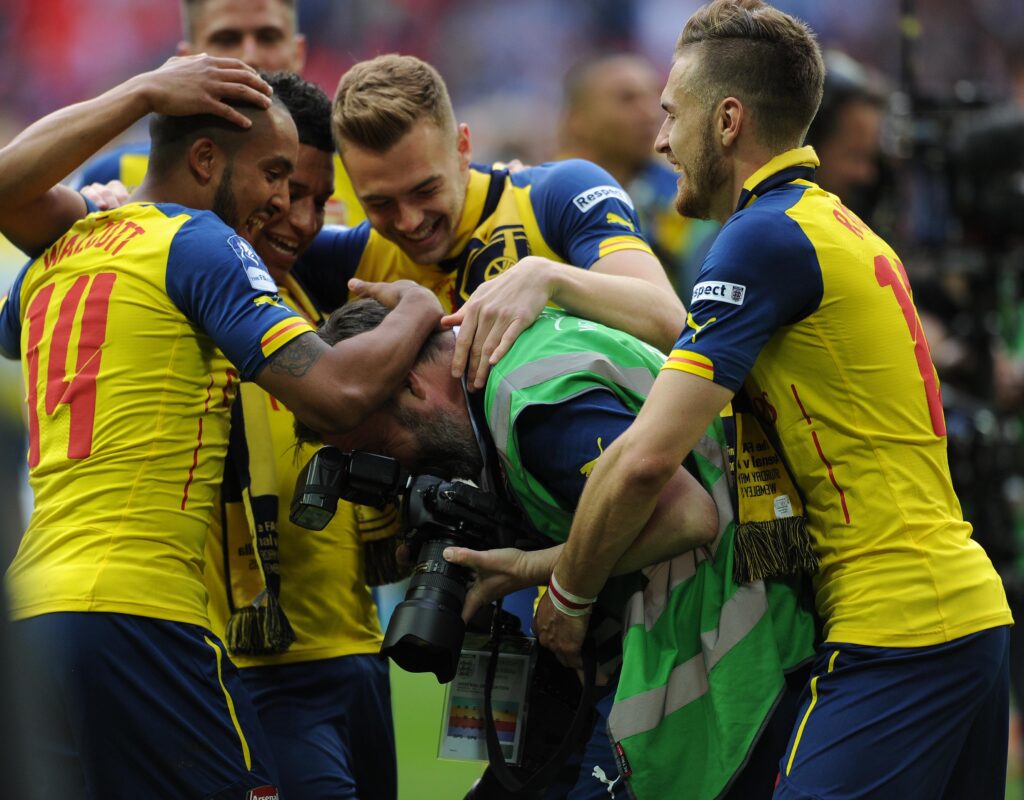
The stories worth telling
Even though the experienced photographer has learned himself not to visibly celebrate, it thus makes a difference whether Arsenal win or lose. The best days of Stuart’s time at Arsenal have been in relation to some of the most iconic triumphs in the club’s history. And Stuarts most iconic photography’s has also been taken during those moments, the photographer admits:
“I get asked a lot what my favourite picture is. All pictures are linked to moments. Really, an iconic picture is linked to a great moment. It might not be the best picture. I got a nice picture of Sylvain Wiltord scoring the goal that won Arsenal the league at Old Trafford and that is an iconic picture. It is not a great photo, but when I think of it, I’m proud of it, because it was the goal that won Arsenal the league. It is about capturing the moment in time”.
“The best days have been when we win big games or cup finals or win the league. The 2014 Cup Final for example, because we were 9 years without a trophy. It was a great day, a great weekend with the parade. And on top of it, between David (David Price, club photographer) and I, we got all the great pictures from the game, and we got everything sent out to our clients. Some really lovely images as well.

Even though the days of big wins and trophies have been the best, Stuart acknowledges that is also can be worth telling stories, that show a less positive side of the club.
“When I first started as the chief photographer, we lost to Liverpool in the FA Cup Final in 2001. I refused to take pictures of the players on the pitch when they were in tears. I thought that they were my work colleagues, so I did not want them to see that I was being disrespectful towards them. But now I think that I’m recording what is happening for the football club historically. So these are the sort of pieces I would take now, but maybe I wouldn’t publish them. I think however there are stories to be told, like the Lucas Torreira-thing. I personally felt that it was something that had to be said because he was visibly upset. Rightly or wrongly of what people thought that happened during that night. I know Lucas, he is a lovely guy and thinks of Arsenal being a family, so it was really a shock to him regarding what happened at the stadium that night”.
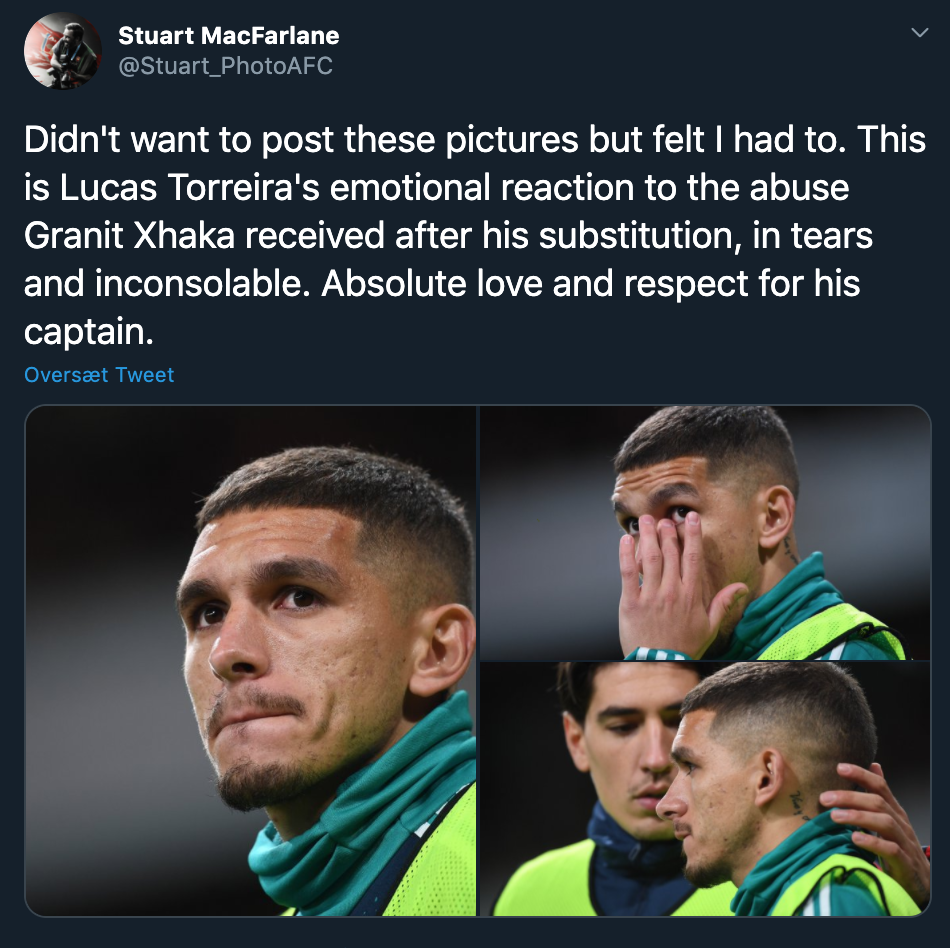
No empty words
Just as for Lucas Torreira, Arsenal is much more than a football club to Stuart. According to Stuart the pictures of the emotional Uruguayan reminds us of Arsenal-fans about the special community, we are a part of. A community, he first felt was all about during his conversations with one of the real veterans at Arsenal:
“When I first came into the club, I spent quite a lot of time with one of the directors, Ken Friar. He is probably the epitome of what the club is all about. I see how he behaved and acted, and thought that it was the way in terms of how to behave. Being respectful. Treating people equally. I think on the whole the club has retained those values. “
For Stuart, the values of the club. Therefore, he occasionally takes part in the debate around the club more like a fan would do to remind fans about the community, they are part of.
“I understand from the club’s perspective that you can’t put forward your own personal opinion through the media channels of the club. As an employee of the club, there is definitely something I shouldn’t put forward but I’m quite an emotional person when it comes to football. I know what the club means to the fans since I’m a supporter myself, so sometimes I put something out where I the next day think, that I perhaps shouldn’t have put it out. But then I think I’m a fan, even though I work for the club, so I’m only echoing what other fans are feeling and thinking as well.”
Through his strong affiliation with the club, Stuart has however not been looked down on in terms of coming with through with an opinion, since he first and foremost tries to vindicate the founding values of the football club. Values Arsenal-fans should remember in their criticism of the current Arsenal-team, Stuart argues. The club hasn´t always been successful like we expect them to be:
“This is not trying to be disrespectful, but a lot of newish fans don’t know about how the club was 30 years ago when massive crowds were gathered into the tiny Highbury when the football wasn’t the best. We were very spoilt with Arsene Wenger and the sort of football we played. As we weren’t doing so great at the start of this season, I remembered back to when we weren’t doing so great a long time ago. I don’t think we can demand the team to be successful all the time because it is competitive football we talk about. We have to realize, that there are better teams than us at the moment, but that we will get back to the top, I think sooner rather than later.
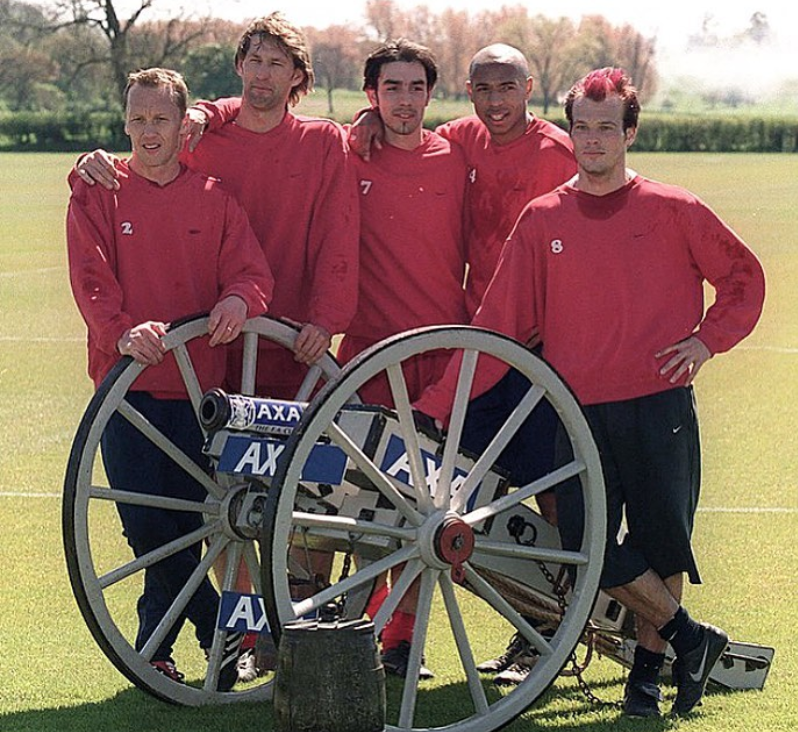
From boyhood to manhood
As a club photographer, Stuart has not only experienced the ups and downs of Arsenal as a whole but also seen how players have evolved and come through the ranks. As a photographer for the U-9-side to the women’s and academy players Stuart has followed the development of the players, but also from the human side of things. From the very first contract to the debut on the first team. Goals, tackles, and long term injuries. Stuart has always been there for the players, first and foremost as a loyal support during both the good and bad times.
“I feel incredibly privileged because you see these young boys come into the club and one of the first places they see is mine, which must be quite scary for them to be fair. And you see them through their career and then they leave, and you don’t always keep in contact with them, but sometimes you do. It is satisfying because you think you have played a really small part in helping their way in their career. I, for example, keep in touch with Alex Iwobi’s dad. I saw him when we played Everton recently. When Alex left the club his dad sent me a really lovely email about what I meant to Alex and his family. It is a lovely thing to get back. For them to say thank you for helping them a long way. I’ve just taken their pictures and been doing my bit to help them along their way a little bit I suppose.”

“Then you sadly have people like Jose Antonio Reyes when he passed away. That was heartbreaking. I met him when he signed, saw him in Madrid the year before (in 2018 at the Real Madrid Legends v Arsenal Legends). I thought he wouldn´t remember me, but he gave me a massive hug. It is those sorts of things where you think that you don´t know what is going to happen in the future. Players get long time injuries that you spent a long time with, and you can how heartbreaking it is for them. But then again that is football and they understand it. The highs, however, outweighs the lows, definitely.”
Even though Stuart has built up a close relationship to some more than others at the club, doesn´t it make him change his attitude and move away from the principals, he brought with him from his conversations with Ken Friar:
“I treat everyone the same. I’ve always been like that. I talk to players the same way. I´m pretty straight down the line. And I think the players appreciate that. Generally, there is not much a difference between the kid that has come out of Hale End and someone that has been bought in from Barcelona. They all just want to do the same thing; to play football.”
“And when a star player comes in, I don’t get starstruck anymore. I got starstruck when I first met Dennis Bergkamp and now, I would like to say that I’m friends with him and his family. When he came over to unveil his statue, he was laughing at me because I was shaking. He knows what I feel about him. I don’t get starstruck in front of Thierry Henry or Patrick Viera, but Dennis was my favourite”.
Stuart has also, outside of Arsenal, had the pleasure to help Bergkamp among others with pictures at special events like weddings, christenings, etc. Stuart admits that is fun for him to do, especially since Arsenal closed their magazine in the summer of 2018 after more than 16 years:
“Football has changed. Back in the day, we could take the player here there and everywhere. You just can’t do that now, they are so famous, we can’t take them out on the street anymore. And understandably there is a lot of restrictions on what we can do and what we can’t do. There are a lot, of the players being pushed and pulled from their sponsors, commercially within and outside of the football club. Our time with them isn’t as much as it used to be, but that is me and David’s problem. It is not a major issue. We have to address it and look at what we can do else and that is something that we’re working on.”
Wenger’s special farewell
Even though it´s been quite some time since Arsenal-fans last time had they joy of celebrating their team winning the league, seeing Stuarts working desk makes you think that the days of success aren’t far away for this great football club. On his desk, you’ll find a winners champagne from the Invincibles 2003/2004-season. The photographer has however no intention to pop it, even if something special should happen for the club or himself.
Getting to know a lot of big personalities and being a loyal member of the Arsenal-family, Stuart has also made himself deserve a few other special pieces of memorabilia. When Thierry Henry left for Barcelona, the Frenchman sent back a shirt from his new club to Stuart as a gesture for his services during his time at Arsenal. The same did Dennis Bergkamp at the end of his last season at Arsenal. The Dutch phenomenon also signed a print of his legendary goal against Newcastle to Stuart with the message, ‘The picture was better than the goal’. However, perhaps the finest recognition Stuart has received was during Arsene Wenger’s last weeks at Arsenal from the man himself.
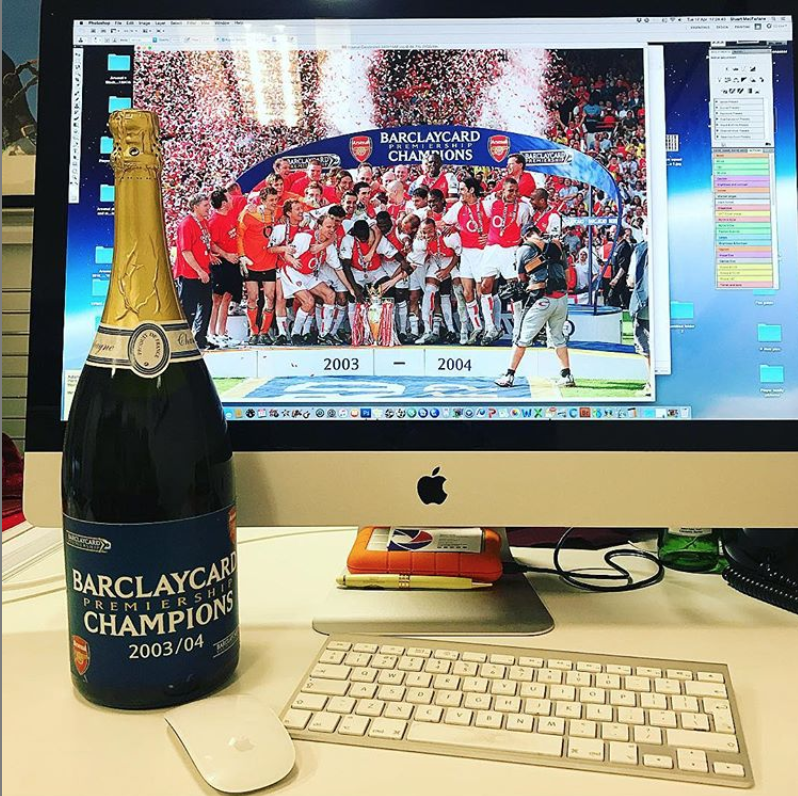
“I did a book a couple of years ago called ‘The Wenger Revolution’. On the cover of the book, there is one of my favourite pictures of Arsene. Just before he left I asked for doing some portraits of him in his office and he invited me in. We had a lovely chat, and I did pictures and I had a print of the cover of the book. I asked him if he would sign it for me. So he kind of took it off me, moved into the corner of the room and he wrote, ‘The star player of my staff for the last 22 years. With love and respect. Arsene Wenger’. I had tears in my eyes and just wanted to give him a massive hug, but I was too respectful to grab him like that. That was lovely.”
Arsene Wenger will always keep a special place in Stuart’s heart. And gratefully, we might have another very special manager on our hands, according to Stuart.
“I would not be where I am without Arsene, and that is 100% true. He is probably one of the most incredible persons I´ve ever met. Just talking to him. Since I first time came in as a full-time photographer for the club, he gave me above anyone else complete access to anything around Arsenal. I was being part of the furniture”
“I was with him the day after he was leaving and it was the same day that my partner had a scan to determine the sex of our baby. We just walked out to the training pitches. I could see how upset he was at leaving and then he talked to me about being a parent, about what was expected of you as a parent, being a good parent. And you know he has so much in the head and he talks to me about my future.”
“The last time I talked to him after Huddersfield, we flew back to the training ground and everyone was saying their goodbyes, and I went over to say goodbye to him and he just grabbed me and said, “You make sure that you look after your child” and that was such a nice thing for him to say. Just a great, great man.”
“I can see so much of Arsene in Mikel Arteta. He reminds of Arsene when he first came in. big boots to fill. The mood was good, obviously, the results weren’t great. Mikel knows the club, understands the club, understands English football and got a massive heart for the club. I know from what he told me, him growing up, he loved watching Arsenal, so he knew all about the club. If you speak to him, you would just believe what he said, because he speaks with such conviction. I´m so pleased that he is the head coach now. Players like a bit of familiarity. When he first came back into the training ground he recognized me and gave me a big hug. He sees me as being a familiar face. It is great for me, for the football club, unbelievable for the fans. I think he’s going to be an amazing football coach for this team.”


